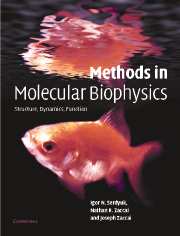Book contents
- Frontmatter
- Contents
- Foreword by D. M. Engelman
- Foreword by Pierre Joliot
- Preface
- Introduction: Molecular biophysics at the beginning of the twenty-first century: from ensemble measurements to single-molecule detection
- Part A Biological macromolecules and physical tools
- Part B Mass spectrometry
- Part C Thermodynamics
- Part D Hydrodynamics
- Part E Optical spectroscopy
- Part F Optical microscopy
- Part G X-ray and neutron diffraction
- Part H Electron diffraction
- Part I Molecular dynamics
- Chapter I1 Energy and time calculations
- Chapter I2 Neutron spectroscopy
- Part J Nuclear magnetic resonance
- References
- Index of eminent scientists
- Subject Index
- References
Chapter I2 - Neutron spectroscopy
from Part I - Molecular dynamics
Published online by Cambridge University Press: 05 November 2012
- Frontmatter
- Contents
- Foreword by D. M. Engelman
- Foreword by Pierre Joliot
- Preface
- Introduction: Molecular biophysics at the beginning of the twenty-first century: from ensemble measurements to single-molecule detection
- Part A Biological macromolecules and physical tools
- Part B Mass spectrometry
- Part C Thermodynamics
- Part D Hydrodynamics
- Part E Optical spectroscopy
- Part F Optical microscopy
- Part G X-ray and neutron diffraction
- Part H Electron diffraction
- Part I Molecular dynamics
- Chapter I1 Energy and time calculations
- Chapter I2 Neutron spectroscopy
- Part J Nuclear magnetic resonance
- References
- Index of eminent scientists
- Subject Index
- References
Summary
Historical overview and introduction to biological applications
We recall from Chapter A1 that biological events occur on an immensely extended range of time scales – from the femtosecond of electronic rearrangements in the first step of vision, to the 109 years of evolution. Thermal energy is expressed as atomic fluctuations on the picosecond–nanosecond time scale that constitute the basis of molecular dynamics. These fluctuations are of particular interest in biophysics because they result from and reflect the forces that structure biological macromolecules and the atomic motions and molecular flexibility associated with biological activity.
Thermal energy propagates through solids in waves of atomic motion, such as the normal modes discussed in Chapters A3 and I1. We can estimate values for the frequencies, wavelengths and amplitudes of thermal excitation waves from an order of magnitude calculation, e.g. by considering the movement of a mass similar to the mass of an atom moving in a simple harmonic potential of energy equal to Boltzmann's constant multiplied by 300 K (ambient temperature). It turns out that the frequencies are of the order of 1012 s−1, while the wavelengths and amplitudes are on the ångström scale. We saw in Part E that the energy associated with thermal vibrations corresponds to the IR frequency range in optical spectroscopy. Similarly, neutron spectroscopy takes advantage of the fact that the energies of thermal neutron beams match vibrational energies in solids and liquids.
- Type
- Chapter
- Information
- Methods in Molecular BiophysicsStructure, Dynamics, Function, pp. 948 - 968Publisher: Cambridge University PressPrint publication year: 2007



